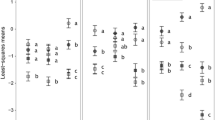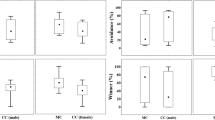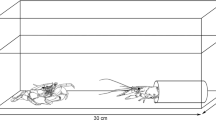Abstract
Biological invasions are a major cause of biodiversity loss, and early action in these cases is more cost-effective than dealing with widespread invasions. Thus, understanding possible consequences of invasions is essential for control and management actions. Given the early stage of invasion of South America by Procambarus clarkii, a potentially harmful crayfish, we investigated aggressive interactions between this invasive crayfish and the native Parastacus brasiliensis to understand potential impacts of the invader on native species before they encounter each other in nature. We paired size-matched crayfish for two experiments: one with Pr. clarkii males and females against Pa. brasiliensis; and another with Pr. clarkii intraspecific interactions. We starved the crayfish then allowed to interact in the presence of food. In interspecific fights we compared the number of attacks, time with the resource, frequency of won interactions of each species and the first species to reach the resource. Regarding the interspecific fights, Pr. clarkii attacked more often, spent more time with the resource, won more interactions and reached the resource first more often than Pa. brasiliensis. Interspecific fights escalated faster than intraspecific fights. The invasive crayfish’s ability to win might be enhanced due to ownership effects, and its impact is likely to be severe because of its life-history traits. We conclude that Pr. clarkii is definitely a threat for native crayfish, requiring that immediate actions be taken, such as dam construction and manual removal of Pr. clarkii.



Similar content being viewed by others
References
Alexander ME, Dick JTA, Weyl OLF, Robinson TB, Richardson DM (2014) Existing and emerging high impact invasive species are characterized by higher functional responses than natives. Biol Lett 10:20130946. doi:10.1098/rsbl.2013.0946
Almeida AO, Buckup L (2000) Occurence of protandric hermaphroditism in a population of the neotropical crayfish Parastacus brasiliensis (Parastacidae). J Crust Biol 20(2):224–230. doi:10.1163/20021975-99990034
Almerão MP, Rudolph EH, Souty-Grosset C, Crandall K, Buckup L, Amouret J, Verdi A, Santos S, Araújo PB (2014) The native South American crayfishes (Crustacea, Parastacidae): state of knowledge and conservation status. Aquat Conserv 25(2):288–301. doi:10.1002/aqc.2488
Balshine S, Verma A, Chant V, Thaysmeyer T (2005) Competitive interactions between round gobies and logperch. J Great Lakes Res 31:67–77. doi:10.1016/S0380-1330(05)70238-0
Barbaresi S, Santini G, Tricarico E, Gherardi F (2004) Ranging behaviour of the invasive crayfish, Procambarus clarkii (Girard). J Nat Hist 38:2821–2832. doi:10.1080/00222930410001663308
Bergman D, Moore PA (2003) Field observations of intraspecific agonistic behavior of two crayfish species, Orconectes rusticus and Orconectes virilis, in different habitats. Biol Bull 205:26–35
Breinholt J, Pérez-Losada M, Crandall KA (2009) The timing of the diversification of freshwater crayfishes. In: Crandall KA, Felder DR (eds) Decapod Crustacean Phylogenetics. CRC Press, Boca Raton, pp 434–456
Bubb DH, Thom TJ, Lucas MC (2006) Movement, dispersal and refuge use of co-occurring introduced and native crayfish. Freshwater Biol 51:1359–1368. doi:10.1111/j.1365-2427.2006.01578.x
Buckup L (2003) Família Parastacidae. In: Melo GAS (ed) Manual de identificação dos Crustacea Decapoda de água doce do Brasil. Editora Loyola, São Paulo, pp 117–141
Chamorro-Florescano IA, Favila ME, Macías-Ordoñez R (2011) Ownership, size and reproductive status affect the outcome of food ball contests in a dung roller beetle: when do enemies share? Evol Ecol 25:277–289. doi:10.1007/s10682-010-9428-8
Chang AL, Grossman JD, Spezio TS, Weiskel HW, Blum JC, Burt JW, Muir AA, Piovia-Scott J, Veblen KE, Grosholz ED (2009) Tackling aquatic invasions: risks and opportunities for the aquarium fish industry. Biol Inv 11:773–785. doi:10.1007/s10530-008-9292-4
Chucholl C (2013) Invaders for sale: trade and determinants of introduction of ornamental freshwater crayfish. Biol Inv 15:125–141. doi:10.1007/s10530-012-0273-2
Collins PA, Giri F, Williner V (2011) Biogeography of the freshwater decapods in the La Plata Basin. South America. J Crust Biol 31(1):179–191. doi:10.1651/10-3306.1
Correia AM, Ferreira O (1995) Burrowing behavior of the introduced red swamp crayfish Procambarus clarkii (Decapoda: Cambaridae) in Portugal. J Crust Biol 15(2):248–257
Dalosto MM, Palaoro AV, Santos S (2012) Mother-offspring relationship in the Neotropical burrowing crayfish, Parastacus pilimanus (von Martens, 1869) (Decapoda: Parastacidae). Crustaceana 85(11):1305–1315. doi:10.1163/156854012X651367
Dalosto MM, Palaoro AV, Costa JR, Santos S (2013) Aggression and life underground: the case of burrowing crayfish. Behaviour 150:3–22. doi:10.1163/1568539X-00003034
Dana ED, García-de-Lomas J, González R, Ortega F (2011) Effectiveness of dam construction to contain the invasive crayfish Procambarus clarkii in a Mediterranean mountain stream. Ecol Eng 37:1607–1613. doi:10.1016/j.ecoleng.2011.06.014
Diéguez-Uribeondo J, Söderhäll K (1993) Procambarus clarkii Girard as a vector for the crayfish plague fungus, Aphanomyces astaci Schikora. Aquacult Fish Manage 24:761–765. doi:10.1111/j.1365-2109.1993.tb00655.x
Duggan IC, Rixon CAM, MacIsaac HJ (2006) Popularity and propagule pressure: determinants of introduction and establishment of aquarium fish. Biol Inv 8:377–382. doi:10.1007/s10530-004-2310-2
Elvey W, Richardson AMM, Barmuta L (1996) Interactions between the introduced yabby, Cherax destructor, and the endemic crayfish, Astacopsis franklinii, in Tasmanian Streams. Freshwater Crayfish 11:349–363
Fero K, Moore PA (2008) Social spacing of crayfish in natural habitats: what role does dominance play? Behav Ecol Sociobiol 62:1119–1125. doi:10.1007/s00265-007-0540-x
Ficetola GF, Siesa ME, Manenti R, Bottoni L, De Bernardi F, Padoa-Schioppa E (2011) Early assessment of the impact of alien species: differential consequences of an invasive crayfish on adult and larval amphibians. Div Distr 17:1141–1151. doi:10.1111/j.1472-4642.2011.00797.x
Fontoura NF, Buckup L (1989a) O crescimento de Parastacus brasiliensis (von Martens, 1869) (Crustacea, Decapoda, Parastacidae). Rev Bras Biol 49(4):897–909
Fontoura NF, Buckup L (1989b) Dinâmica populacional e reprodução em Parastacus brasiliensis (von Martens, 1869) (Crustacea, Decapoda, Parastacidae). Rev Bras Biol 49(4):911–921
Genovesi P (2011) Are we turning the tide? Eradications in times of crisis: how the global community is responding to biological invasions. In: Veitch CR et al (eds) Island Invasives: Eradication and Management. IUCN, Gland, Switzerland, pp 5–8
Gherardi F (2002) Behaviour. In: Holdich DM (ed) Biology of freshwater crayfish, 1st edn. Blackwell Science, Oxford, pp 258–290
Gherardi F (2006) Crayfish invading Europe: the case study of Procambarus clarkii. Mar Fresh Beh Physiol 39(3):175–191. doi:10.1080/10236240600869702
Gherardi F, Cioni A (2004) Agonism and interference competition in freshwater decapods. Behaviour 141(10):1297–1324
Gherardi F, Daniels WH (2004) Agonism and shelter competition between invasive and indigenous crayfish species. Can J Zool 82:1923–1932. doi:10.1139/z04-185
Gherardi F, Aquiloni L, Diéguez-Uribeondo J, Tricarico E (2011) Managing invasive crayfish, is there a hope? Aq Sciences 73:185–200. doi:10.1007/s00027-011-0181-z
Gherardi F, Coignet A, Souty-Grosset C, Spigoli D, Aquiloni L (2013) Global warming and the agonistic behaviour of invasive crayfishes in Europe. Freshw Biol 58:1958–1967. doi:10.1111/fwb.12183
Hammer Ø, Harper DAT, Ryan PD (2001) PAST: paleontological Statistics Software Package for education and data analysis. Palaeontologia Electronica 4:1–9
Hazlett BA, Lawler S, Edney G (2007) Agonistic behavior of the crayfish Euastacus armatus and Cherax destructor. Mar Freshw Beh Physiol 40(4):257–266. doi:10.1080/10236240701562412
Herberholz J, McCurdy C, Edwards DH (2007) Direct benefits of social dominance in juvenile crayfish. Biol Bull 213:21–27
Holway DA, Suarez AV (1999) Animal behavior: an essential component of invasion biology. Trends Ecol Evol 14(8):328–330. doi:10.1016/S0169-5347(99)01636-5
Huner JV (2002) Procambarus. In: Holdich DM (ed) Biology of freshwater crayfish, 1st edn. Blackwell Science, Oxford, pp 541–584
Instituto Brasileiro do Meio Ambiente e dos Recursos Naturais Renováveis (IBAMA). Resolution no 5, January 28th, 2008
Jimenes SA, Faulkes Z (2011) Can the parthenogenetic marbled crayfish Marmorkrebs compete with other crayfish species in fights? J Ethol 29:115–120. doi:10.1007/s10164-010-0232-2
Kerby JL, Riley SPD, Kats LB, Wilson P (2005) Barriers and flow as limiting factors in the spread of an invasive crayfish (Procambarus clarkii) in southern California streams. Biol Cons 126:402–409. doi:10.1016/j.biocon.2005.06.020
López P, Martín J (2011) Male Iberian rock lizards may reduce the costs of fighting by scent matching of the resource holders. Behav Ecol Sociobiol 65:1891–1898. doi:10.1007/s00265-011-1198-y
Loureiro TG, Anastácio PM, Bueno SLS, Araújo PB, Souty-Grosset C, Almerão MP (2015a) Distribution, introduction pathway and invasion risk analysis of the North American crayfish Procambarus clarkii (Crustacea, Decapoda, Cambaridae) in Southeast Brazil. J Crust Biol 35(1):88–96. doi:10.1163/1937240X-00002307
Loureiro TG, Anastácio PMSG, Araujo PB, Souty-Grosset C, Almerão MP (2015b) Red swamp crayfish: biology, ecology and invasion—an overview. Nauplius 23(1):1–19. doi:10.1590/S0104-64972014002214
Lynch BR, Rochette R (2009) Spatial overlap and interaction between sub-adult American lobsters, Homarus americanus, and the invasive European green crab Carcinus maenas. J Exp Mar Ecol Biol 369:127–135. doi:10.1016/j.jembe.2008.11.002
MacNeil C, Dick JTA, Platvoet D, Briffa M (2011) Direct and indirect effects of species displacements: an invading freshwater amphipod can disrupt leaf-litter processing and shredder efficiency. J N Am Benthol Soc 30(1):38–48. doi:10.1899/10-056.1
Macom TE, Porter SD (1996) Comparison of polygyne and monogyne imported red fire ant (Hymenoptera: Formicidae) population densities. Annals of the Entomol Soc Amer 89:535–543
Magalhães C, Bueno SLS, Bond-Buckup G, Valenti WC, Silva HLM, Kiyohara F, Mossolin EC, Rocha SS (2005) Exotic species of freshwater decapod crustaceans in the state of São Paulo, Brazil: records and possible causes of their introduction. Biodivers Cons 14:1929–1945. doi:10.1007/s10531-004-2123-8
Maynard-Smith J, Parker PA (1976) The logic of asymmetric contests. Anim Behav 4:159–175
Meinesz A (2001) Killer Algae, University of Chicago Press, Chicago, p 360
Mohamad R, Monge J, Goubault M (2012) Do resource value and ownership status affect intensity and resolution of contests in a parasitoid wasp? Entomol Exp Appl 147:99–109. doi:10.1111/eea.12049
Moore PA (2007) Agonistic behavior in freshwater crayfish: the influence of intrinsic and extrinsic factors on aggressive encounters and dominance. In: Duffy JE, Thiel M (eds) Evolutionary Ecology of Social and Sexual Systems - Crustaceans as Model Organisms. Oxford University Press, Oxford, pp 90–114
Moorhouse TP, Macdonald DW (2011) The effect of removal by trapping on body condition in populations of signal crayfish. Biol Cons 144:1826–1831. doi:10.1016/j.biocon.2011.03.017
Mrugała A, Kozubíková-Balcarová E, Chucholl C, Cabanillas Resino S, Viljamaa-Dirks S, Vukić J, Petrusek A (2014) Trade of ornamental crayfish in Europe as a possible introduction pathway for important crustacean diseases: crayfish plague and white spot syndrome. Biol Inv 12:1313–1326. doi:10.1007/s10530-014-0795-x
Oluoch AO (1990) Breeding biology of the Louisiana red swamp crayfish Procambarus clarkii Girard in Lake Naivasha, Kenya. Hydrobiologia 208:85–92. doi:10.1007/BF00008447
Palaoro AV, Dalosto MM, Costa GC, Santos S (2013a) Niche conservatism and the potential for the crayfish Procambarus clarkii to invade South America. Freshwater Biol 58:1379–1391. doi:10.1111/fwb.12134
Palaoro AV, Dalosto MM, Coutinho C, Santos S (2013b) Assessing the importance of burrows through behavioral observations of Parastacus brasiliensis, a Neotropical burrowing crayfish (Crustacea), in laboratory conditions. Zool Stud 52:4. doi:10.1186/1810-522X-52-4
Panzacchi M, Bertolino S, Cocchi R, Genovesi P (2007) Population control of coypu Myocastor coypus in Italy compared to eradication in UK: a cost-benefit analysis. Wildl Biol 13(2):159–171. doi:10.2981/0909-6396(2007)13[159:PCOCMC]2.0.CO;2
Penn GH (1943) A study of the life history of the Louisiana red-crawfish. Cambarus clarkii Girard. Ecology 24(1):1–18
Pintor LM, Sih A, Bauer M (2008) Differences in aggression, activity and boldness between native introduced populations of an invasive crayfish. Oikos 117:1629–1636. doi:10.1111/j.1600-0706.2008.16578.x
R Development Core Team (2013) R: A language and environment for statistical computing. R Foundation for Statistical Computing, Vienna
Rejmánek M, Pitcairn MJ (2002) When is eradication of exotic pest plants a realistic goal? In: Veitch CR, Clout MN (eds) Turning the tide: the eradication of invasive species, IUCN SSC invasive species specialist group, pp 249–253
Reynolds J, Souty-Grosset C (2012) Management of freshwater biodiversity: crayfish as bioindicators. Cambridge University Press, Cambridge, p 384
Rudolph EH, Almeida AO (2000) On the sexuality of South American Parastacidae (Crustacea, Decapoda). Invertebr Reprod Dev 37(3):249–257. doi:10.1080/07924259.2000.9652425
Scalici M, Chiesa S, Scuderi S, Celauro D, Gilbertini D (2010) Population structure and dynamics of Procambarus clarkii (Girard, 1852) in a Mediterranean brackish wetland (Central Italy). Biol Inv 12:1415–1425. doi:10.1007/s10530-009-9557-6
Schrimpf A, Maiwald T, Vrålstad T, Schulz HK, Śmietana P, Schulz R (2013) Absence of the crayfish plague pathogen (Aphanomyces astaci) facilitates coexistence of European and American crayfish in central Europe. Freshwater Biol 58:1116–1125. doi:10.1111/fwb.12112
Shine R (2014) A review of ecological interactions between native frogs and invasive cane toads in Australia. Austral Ecol 39:1–16. doi:10.1111/aec.12066
Silva HLM, Bueno SLS (2005) Population size estimation of the exotic crayfish Procambarus clarkii (Girard) (Crustacea, Decapoda, Cambaridae) in the Alfredo Volpi City Park, São Paulo. Brazil. Rev Bras Zool 22(1):93–98. doi:10.1590/S0101-81752005000100012
Simberloff D (2013) Biological invasions: what’s worth fighting and what can be won? Ecol Eng 65:112–121. doi:10.1016/j.ecoleng.2013.08.004
Simberloff D, Martin J, Genovesi P, Maris V, Wardle DA, Aronson J, Courchamp F, Galil B, García-Berthou E, Pascal M, Pyšek P, Sousa R, Tabacchi E, Vilà M (2013) Impacts of biological invasions: what’s what and the way forward. Trends Ecol Evol 28(1):58–66. doi:10.1016/j.tree.2012.07.013
Sousa R, Freitas FEP, Mota M, Nogueira AJA, Antunes C (2013) Invasive dynamics of the crayfish Procambarus clarkii (Girard, 1852) in the international section of the River Minho (NW of the Iberian Peninsula). Aquatic Conserv Mar Freshw Ecosyst 23:656–666. doi:10.1002/aqc.2323
Souty-Grosset C, Holdich DM, Noël PY, Reynolds JD, Haffner P (2006) Atlas of Crayfish in Europe. Museum national d’Histoire naturelle, Paris, 187 pp (Patrimoines naturels, 64)
Souty-Grosset C, Reynolds J, Gherardi F, Aquiloni L, Coignet A, Pinet F, Del Mar Mancha Cisneros M (2014) Burrowing activity of the invasive red swamp crayfish, Procambarus clarkii, in fishponds of La Brenne (France). Ecol Ethol Evol 26(2–3):263–276. doi:10.1080/03949370.2014.892538
Unestam T (1975) Defence reactions in and susceptibility of Australian and New Guinean freshwater crayfish to European-crayfish-plague fungus. Australian J Exp Biol Med 53:349–359
Vander Zanden MJ, Hansen GJA, Higgins SN, Kornis MS (2010) A pound of prevention, plus a pound of cure: early detection and eradication of invasive species in the Laurentian Great Lakes. J Great Lakes Res 36:199–205. doi:10.1016/j.jglr.2009.11.002
Vandermeer RK, Obin MS, Morel L (1991) Nestmate recognition in fire ants: monogyne and polygyne populations. In: Jaffe K, Cedeno A (eds) Vandermeer RK. A World Perspective, Westview Press, Applied Myrmecology, pp 322–328
Vorburger C, Ribi G (1999) Aggression and competition for shelter between a native and an introduced crayfish in Europe. Freshw Biol 42(1):111–119. doi:10.1046/j.1365-2427.1999.00465.x
Wang W, Gu W, Ding Z, Ren Y, Chen J, Hou Y (2005) A novel Spiroplasma pathogen causing systemic infection in the crayfish Procambarus clarkii (Crustacea: Decapod), in China. FEMS Micriobiol Lett 249:131–137. doi:10.1016/j.femsle.2005.06.005
Westermann FL, Suckling DM, Lester PJ (2014) Disruption of foraging by a dominant invasive species to decrease its competitive ability. PLoS ONE 9(3):e90173. doi:10.1371/journal.pone.0090173
Williams PJ, Floyd TA, Rossong MA (2006) Agonistic interactions between invasive green crabs, Carcinus maenas (Linnaeus), and sub-adult American lobsters, Homarus americanus (Milne Edwards). J Exp Mar Ecol Biol 329:66–74. doi:10.1016/j.jembe.2005.08.008
Woodfield R, Mooney R (2002) Field Response to infestations of Caulerpa taxifolia in Southern California. California and the World Ocean 2002 Proceedings
Acknowledgments
We thank CAPES (Coordenação de Aperfeiçoamento de Pessoal de Nível Superior) for the scholarship for A.V.P. and T.G.L., CAPES/FAPERGS (Fundação de Amparo à Pesquisa do Estado do Rio Grande do Sul) for the scholarship to M.M.D. and CNPq (Conselho Nacional de Desenvolvimento Científico e Tecnológico) for the productivity grant to S.S (Process No: 311142/2014-1) and P.B.A (Process No: 302274/2011-1). This work was also supported by CAPES/COFECUB (international consortium Brazil - France) (Project: Freshwater limnetic ecosystems and conservation of freshwater crayfish of the genus Parastacus in southern Brazil - 8209/2012), We thank Mr. Alderi Baggio, Mrs. Lúcia Baggio, and Mr. Charles Zarantonello for allowing us to collect Pa. brasiliensis on their properties, and the staff from the Alfredo Volpi Park for allowing us to collect Pr. clarkii. We thank Nilton Carlos Cáceres, Thomas Heinrich Breithaupt, Gabriel Costa, Ana Beatriz Barros de Morais and two anonymous reviewers for their valuable comments that improved the manuscript. Lastly, we thank our colleagues from the Núcleo de Estudos em Biodiversidade Aquática for their help in collecting, transporting and maintaining the crayfish, and also during the execution of the experiments.
Author information
Authors and Affiliations
Corresponding author
Ethics declarations
Conflicts of interest
None.
Electronic supplementary material
Below is the link to the electronic supplementary material.
Rights and permissions
About this article
Cite this article
Dalosto, M.M., Palaoro, A.V., Souty-Grosset, C. et al. One step ahead of the enemy: investigating aggressive interactions between invasive and native crayfish before the contact in nature. Biol Invasions 17, 3503–3515 (2015). https://doi.org/10.1007/s10530-015-0974-4
Received:
Accepted:
Published:
Issue Date:
DOI: https://doi.org/10.1007/s10530-015-0974-4




